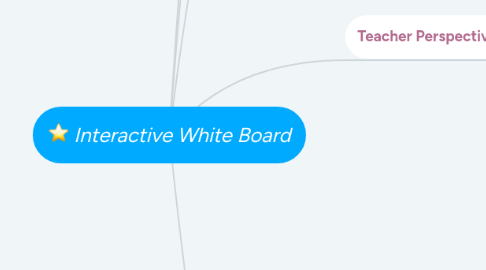
1. What is an Interactive White Board?
1.1. Is a technology made up of a computer connected to both a projector and a touch-sensitive board that presents the pictures projected from the computer, allows for changes, and receives input electronically or by touch
2. The IWB have activities unique to this technology:
2.1. Animation
2.2. Drag and drop
2.3. Hide and reveal
2.4. Highlighting
2.5. Feedback
3. Learner Perspectives
3.1. Attitudes towards Learning
3.1.1. Students reported that the use of the IWB enhances motivation to learn, raises the level of concentration, improves behavior, and enhances learning because it is “fun” and innovative. Students who learned with the IWB were more attentive and engaged in learning, participated more actively in the classroom, and interacted much more with their teachers, their peers.
3.2. Developing 21st Century Thinking and Learning Skills
3.2.1. The five central skills were as follows: 1. Information skills (literacy): Skills that relate to the ability to gather, edit, analyze, process, and connect information. 2. Higher order thinking skills: In particular, problem solving, critical thinking, and creative and entrepreneurial thinking. 3. Communication and cooperation skills: The ability to work in a team, and to belong to various communities. 4. Skills to use technological tools, despite the feeling that young people know how to do this. 5. Learning skills: In particular, the development of autonomous learning.
3.3. The Relationship between Use of IWBs and Student Achievement
3.3.1. Significant statistical differences were reported between the groups’ achievements, such that the group that learned with the IWB achieved higher scores. IWBs positively influenced students’ ability to understand complex concepts
4. Teacher Perspectives
4.1. Teachers’ Attitudes toward Working with IWBs
4.1.1. studies have found positive teacher attitudes towards working with IWBs. Moss et al found that teachers feel that working with IWBs makes them more up-to-date, the teachers find working with IWBs relatively easy. While the preparation time for lessons is longer, the resulting value is worthwhile, that is, greater student motivation and concentration, support for various learning styles (visual and aural), materials that can easily be adapted for children of varying abilities, the preparation of a better lesson.
4.2. Developmental Typology of Teachers Using IWBs
4.2.1. 1. First stage: Teachers match the new technology to existing pedagogy. 2. Second stage: Teachers are involved with discovering new opportunities offered by these technologies. 3. Third stage: Skilled teachers use the IWB in a professional and intuitive manner, which broaden or change their traditional pedagogy.
4.3. Pedagogical Practices Using IWBs
5. Discussion
5.1. Student Perspective
5.1.1. Contribution to students’ engagement in the lesson
5.1.1.1. The findings of this study reveal that student attitudes toward learning with the IWB are predominantly positive. Despite these positive reports on the contribution of the IWB to student learning, other studies highlight that the increase in student engagement may only be short-term. In order to maintain their level of engagement and their interest in learning, instruction via the IWB needs to be more challenging than just demonstrating simple assignments on the board.
5.1.2. Developing 21st century skills
5.1.2.1. learning skills that focus on the development of an autonomous learner
5.1.2.2. An additional contribution that comes up in the literature and is connected to the development of higher order thinking skills relates to the ability to better present the learning material, to provide clarifications and visual presentation, using models and explanations to teach complicated concepts
5.1.3. The relationship between IWB use and attitudes toward achievement
5.1.3.1. The results of our study indicate that the majority of teachers and innovation leaders and a portion of the principals think that learning via the IWB can positively influence student achievements. On the other hand, less than one-third of students (36%) feel that their achievements will improve following learning with the IWB, and a majority of them (58%) feel that their achievements will remain the same.
5.2. Teacher Perspective
5.2.1. Teacher attitude towards use of the IWB
5.2.1.1. The teachers report that despite the difficulty of dedicating more time to preparing lessons, the upside is greater student interest, motivation, and focus, support for different learning styles (aural and visual), materials that are more easily adapted to students with varying abilities, planning a better lesson, presenting the learning material more clearly.
5.2.2. Interactive teaching
5.2.2.1. Based on the current study, a number of recommendations emerge: • It is important to train teachers to utilize the technology for new pedagogical purposes. • It may be helpful to establish a database of lessons and instructional materials that integrate various technological elements in order to ease the burden on teachers in preparing interactive lessons. • Adding smart classrooms in the school (at least 50% of the classrooms) may help create continuity in the innovative methods of learning and instruction for most of the students. • It may be important to consider the integrated model of installing smart classrooms in both homeroom classes as well as in specific departments
